Click On Image
For Full Size | Size |
Image Description |
Source |
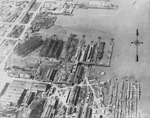
0814300 |
7.80k |
Union Iron Works, San Francisco, California.
Photographed during World War I, with four-piper destroyers under construction at the Risdon Iron Works in the lower right. Four submarines and one destroyer hull in dry-dock are at the piers in the center, along with some large merchant ships. Risdon, part of Union, is to the lower right of the ink line. 1-Cafeteria, 2-Store room, 3-Iron Foundry, 4-Brass Foundry, 5-Machine shop, 6-Pattern shop, 7-Erecting machine shop, 8-Administration building, 9-Power house, 10-office bldg., Govt. offices, 11-Blacksmith shop, 12-Bioler shop, 13-Joiner shop, 14-Joiner shop, Annex with oil storage tanks underneath, 15-Warehouse and office bldg., 16-Pipe and copper shop, 17-Steel storage, 18-Plate shop, 19-Gate house, 20-Building slips 4&5, 21-Building slips 1.2 & 3, 22-Wharf #2, 23-Wharf #3, 24-Floating dock, capacity 2000 tons, 25-Floating dock, capacity 6500 tons, 26-Wharf #4, 27-Wharf #5, S-Storage space 2--Risdon Plant shown south and east of red lines: 1-Copper storage, 2- Oil tank, 3-Office building, 4-Office building, 5-Yarrow boiler shop, 6-Warehouse, 7-Power house, 8-Blacksmith shop, 9-Storehouse, 10-Sheet metal shop, 11-Sheet metal shop, 12-Marine machine shop, 13-Wharves, 14-Wharves, 15-Wharves.
Appearing here in no order are vessels that were constructed but not necessarily here:
6 of 27 R-class submarines
first keel laid: R-16 (SS-93), 26 April 1917, last: R-19 (SS-96), 23 June 1917
first launch: R-15 (SS-92), 10 December 1917, last: R-19, 28 January 1918
R-15 (SS-92) ... R-20 (SS-97)
12 of 51 S-class submarines
S-30 (SS-135) ... S-41 (SS-146)
26 of 111 Wickes-class destroyers for the United States Navy between 1917 and 1919
first keel laid: Ringold (DD-89), 20 October 1917, last: Stansbury (DD-180), 9 December 1918
first launch: McKee (DD-87), 23 March 1918, last: Stansbury, 16 May 1919,
8 are launched on 4 July 1918
McKee (DD-87) ... Gridley (DD-92),
Schley (DD-103),
... Ludlow (DD-112),
Burns (DD-171) &
... Stansbury (DD-180)
40 of 156 Clemson-class destroyers for the United States Navy between 1918 and 1921
Chauncey (DD-296) ... Melvin (DD-335)
|
Photo courtesy of history.navy.mil |
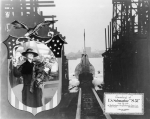 |
115k |
A composite photo marking the launching of S-31 (SS-136) at Bethlehem Shipbuilding Corp, Ltd., Union Plant, Potrero Wks. on 28 December 1918. The ship's sponsor Mrs. George A. Walker is shown on the left. |
USN photo courtesy of Darryl L. Baker. |
 |
113k |
The S-boat was the culmination of E.B. single-hull design for the U.S. Navy. This is a typical unit of the S-30-41 (SS-135-46) group, as completed. Ballast trunks are indicated. Lines below the hull show the location of the fuel tanks forward & aft (the foremost two tanks of the after group are the lubricating oil tank & sump tank). Arrows indicate the two Fessenden oscillators under the boat's keel, fore & aft. Arrows in the bridge structure indicate the three periscopes (one in the conning tower, soon removed) the telescoping radio mast & the radio tube leading down into the radio room.
In the control room the wheels controlling the planes were on the port side: the three levers for the Kingston valves were on the opposite side, abaft the chart table. The radio room, (below the radio tube, into which the antenna leads ran) was set into the after port side of the control room.
Abaft the main motors were auxiliaries: the low pressure main ballast pump on the center-line, the high pressure main ballast pump on the starboard shaft, the motor for the Fessenden oscillator on the port shaft.
|
Drawing & Text courtesy of U.S. Submarines Through 1945, An Illustrated Design History by Norman Friedman. Naval Institute Press.
|
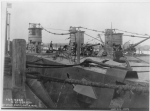 |
92k |
Tied up along the dock from left to right:
S-21 (SS-126), S-34 (SS-139) and S-31 (SS-136) at Groton CT., 9 June 1923.
| USN photo # 19-N-10269, from the National Archives and Records Administration (NARA), courtesy of Daniel Dunham. |
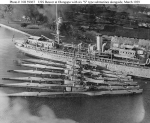 |
122k |
Beaver (AS-5)
at Olongapo, Philippines, with six submarines alongside, in March 1929.
The submarines are (from front to rear):
S-32 (SS-137),
S-35 (SS-140),
S-30 (SS-135),
S-33 (SS-138),
S-31 (SS-136), &
S-34 (SS-139).
| USNHC photograph # NH 59967.
|
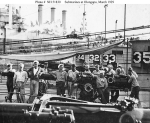 |
128k |
Submarines at Olongapo Naval Station, Philippines.
Crewmen posing with a 4"/50 deck gun on board a "S-Type" submarine, March 1929, with another 4"/50 in the foreground. These submarines are probably S-30 (SS-135) and S-31 (SS-136).
Behind them are (from front to rear):
S-35 (SS-140),
S-33 (SS-138);
S-32 (SS-137);
and
S-34 (SS-139).
Photographed from Beaver (AS-5). In the background is Pittsburgh (CA-4), in the Dewey drydock.
| USNHC photograph # NH 51830.
|
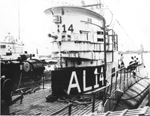 |
385k |
Live from Hollywood, SEA.S.I. Celluloid Investigators Case AL-14/S23-31
This photo & the one below initially caused some confusion, because the numbering of the L boats ended with 11. The text is compiled from a series of emails.
The boat is an S boat but the "AL" designation was for American "L" class subs operating in the British Isles during WW I so as not to confuse them with the British "L" class boats working there too.
The book "Pigboats" written by Edward Ellsberg was made into a movie called "Hell Below" about WW I submarines. It would appear that more than one submarine was used in the movie, with S-31 (SS-136) getting the starring role but S-23 (SS-128) appears to be her understudy and appears here in these photos, with Jimmy Durante on the deck of the S-23 during a break in movie making.
You can see the "AL 14" on the front of the conning tower.
This submarine was thought to be the S-31 (SS-136). Unfortunately, given what I said above, this boat can not be the S-31! Other confirmed photos of the S-31 show her with the typical rounded fairings of the 30 series.
It has to be a 20 series boat, and my research shows that it has to be one of the following boats: S-18, S-21, S-23 to 27, or S-29. All of these boats were in Pearl Harbor with the S-28 when the photo was taken. I found it a little surprising that the movie company would travel all the way to Hawaii in 1932-33 at the height of the Depression to film on board a submarine, when they could have traveled to San Pedro or Groton for a lot less money and filmed on an R-boat.
To confirm the candidate, a email request for the boat's log was sent to National Archives and Records Administration
(NARA), which responded with this message:
We located the following text in the log of the S-31 on Friday February 3, 1933:
"4 to 8(AM) Moored as before. At 0710 underway on motors, various courses and speeds to conform with harbor,
standing out to operated with Metro-Goldwyn-Mayer Motion Picture Corp. At 0722 ahead both engines. At 0723
Breakwater light abeam to port. At 0725 cleared channel, set course 155 true, 144 psc. At 0750 changed course
to 145 true. At 0752 stopped both engines, rigged ship for dive. At 0756 ahead port engine, set course 145
true."
Okay, so what do we make of this development?
On the surface (excuse the pun!) it seems as if this is a slam dunk. The mention of the movie company in the boat's deck log seems to confirm it. But what if, due to some Navy operational commitment for the S-31, the movie company was forced to film portions of the movie on a different boat? What if the S-31 had to get under way for a mission when the movie company wanted to film some alongside shots? The S-23 may have been available so they did a quick paint job on her and dressed her up as a replacement AL-14.
This may seem like I am trying to rationalize my way around the log entry, but I have good reason to. I have seen three separate confirmed photos of the S-31 with the rounded bow plane fairings, completely different from the flat angle fairings of the boat in the AL-14 photo (typical of the boats in the 20 series). One of these photos was taken early in her career, but two were taken at about the same time as the AL-14 photo (one of which is on Looking Glass!). I can not think of a logical reason why the Navy would go to all the time, effort, and expense of replacing the smaller rounded fairings with the larger flat angle fairings! It doesn't make sense! There is no mechanical or structural advantage that I know of and the larger fairings would have actually created more drag. The pattern of flat angle fairings for the 20 series boats and rounded fairings for the 30 series boats is very consistent across the board. The only exception is the S-19. She had the rounded 30 series fairings, but she was built that way and had them her whole life.
The only thing that makes sense to me is that MGM filmed on board both the S-23 and the S-31 for some reason.
|
Text & Photo i.d. courtesy of Ric Hedman & David Johnston Susan Abbott, Archivist, Old Navy and Maritime Records, Archives I Textual Reference Section, National Archives and Records Administration.
USN photo courtesy of Scott Koen & ussnewyork.com. |
 |
296k |
S-28 (SS-133) with the S-23 (SS-128) dressed up for her part in the 1933 movie "Hell Below" wearing the fictional "AL-14" for Hollywood and country. |
Text & Photo i.d. courtesy of Ric Hedman.
USN photo courtesy of Scott Koen & ussnewyork.com. |
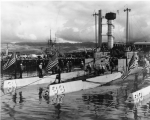 |
262k |
Stern view of the S-31 (SS-136), S-33 (SS-138) , and S-32 (SS-137) (just visible) at Pearl Harbor cirica mid 1930's. On the far left of the photo, on the other side of the pier, the bow of the Argonaut (SS-166) is just visible. The after superstructure skeg has already been cut away as part of a safety and maintenance program initiated after the S-4 (SS-109) disaster.
|
Text courtesy of David Johnston.
USN photo courtesy of Darryl L. Baker. |
 |
588k |
S-31 (SS-136) entering Pearl Harbor, circa 1932. |
USN photo # 19-N-17937, probably from Tai Sing Loo, from the National Archives and Records Administration (NARA), courtesy of Daniel Dunham. |
 |
54k |
From outboard to inboard, S-31 (SS-136), S-35 (SS-140), S-33 (SS-138), and S-34 (SS-139), probably in the Philippines. |
Vance Adams for his father, Lt. Vance Adams USN Ret (deceased). |

0813610 |
495k | S boats exercising in Hawaii, circa mid 30's: S-31 (SS-136) in the foreground.
| Photo courtesy of David Wright. |
 |
20k |
Commemorative post mark on the occasion of the decommissioning of Submarine Divison 9 on 7 December 1937. The subs appearing are:
S-30 (SS-135)
S-31 (SS-136)
S-32 (SS-137)
S-33 (SS-138)
S-34 (SS-139)
&
S-35 (SS-140).
|
Courtesy of Jack Treutle (of blessed memory). |
 |
119k |
Commemorative post mark on the occasion of the decommissioning of S-31 (SS-136) at League Island, 7 December 1937. |
Photo courtesy of Tommy Trammp. |
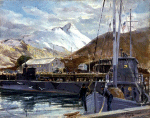 |
73k |
An 1942 oil painting on board, by the artist William F. Draper entitled "Sub and Yippy Tie Up."
In a quiet inlet of the Bering Sea in 1942, a YP boat gets a coat of paint and an S-boat ties up for fuel and provisions. The short Alaskan day is ending and lights may be seen in the barracks until total
darkness requires a blackout.
The S-boats that served in the Aleutians theater were:
S-18 (SS-123),
S-23 (SS-128),
S-27 (SS-132),
S-28 (SS-133),
S-30 (SS-135),
S-31 (SS-136),
S-32 (SS-137),
S-33 (SS-138),
S-34 (SS-139),
S-35 (SS-140),
S-36 (SS-141),
S-40 (SS-145),
S-41 (SS-146),
S-42 (SS-153),
S-44 (SS-155),
S-45 (SS-156),
S-46 (SS-157), &
S-47 (SS-158).
| Sub and Yippy Tie Up by William F. Draper.
Painting #13 /
88-189-N. Courtesy of the USNHC. |
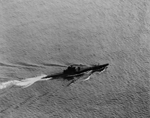 |
2.80k |
Air view of S-Class submarine S-31 (SS-136) at an altitude of about 500 feet, 12 March 1943 off San Diego. She provided submarine and sound training services for west coast training commands. |
Photo from Record Group 80: General Records of the Department of the Navy
Series: General Photographic Files
National Archives Identifier: 175540018
Local Identifier: 80-G-63889
Photo courtesy of catalog.archives.gov |
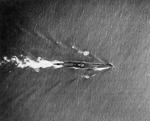
0813611 | 724k |
Air view of S-Class submarine S-31 (SS-136) at an altitude of about 500 feet, 12 March 1943.
| Photo from Record Group 80: General Records of the Department of the Navy
Series: General Photographic Files
National Archives Identifier: 175540020
Local Identifier: 80-G-63892
Photo courtesy of catalog.archives.gov |
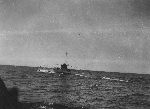 |
107k |
Stern view of the S-31 (SS-136), probably circa WW II. |
USN photo courtesy of CTM Russel Rau, former COB of SS-238 Wahoo, submitted by Bill Rau & Paul Crozier.
|
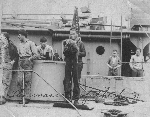 |
167k |
Sailor holding the mascot of the S-31 (SS-136), probably circa WW II.
Victory and the end of the war meant the breaking up of most submarine crews. Garbo, Skeeter, Betty, and other dogs went home with crew members. Porches, lawns, and the occasional cat replaced steel hulls, tile decks, and depth charges. Gabby, mascot of the Gabilan, proudly represented all submarine sea dogs when he marched with his crew in a welcome-home victory parade in Mobile, Alabama, in October 1945. | USN photo courtesy of CTM Russel Rau, former COB of SS-238 Wahoo, submitted by Bill Rau & Paul Crozier.
Pooch text courtesy of the article Sea Dogs by William Galvani in americanheritage.com. |


















